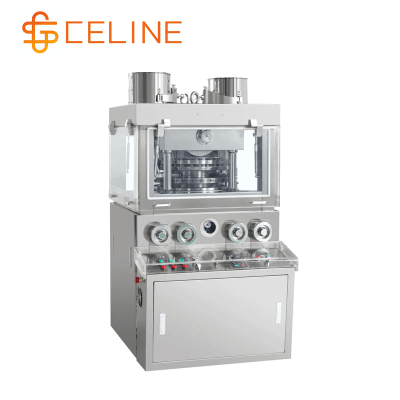Key Operational Steps for Tableting Machine Installation and Debugging
Preliminary Preparation:
Ensure the installation site is flat, well-ventilated, and dry, with a load-bearing capacity matching the weight of the tablet press (to prevent machine swaying). After unpacking, check that the main unit and accessories (molds, pressure rollers, etc.) are intact, and that the instruction manual, certificate of conformity, and other documents are complete. Clean the surface of the equipment of oil and packaging residue.
Main Unit Installation:
Accurately position and level the main unit. Hoist it to the preset position and use a level to calibrate the machine's level (front-to-back and left-to-right deviation ≤ 0.1mm/m). Secure it with anchor bolts to prevent displacement during operation. When connecting the power supply and air source (for pneumatic tablet presses), verify that the voltage and air pressure parameters match the equipment requirements and ensure proper grounding.
Mold Installation:
Proper operation to prevent damage. Before installing the die, clean the die holes and punches, and check the die size's compatibility with the tablet press. Install in the order of "lower punch → middle die → upper punch," ensuring the middle die is firmly fixed and the punch moves smoothly. Avoid die misalignment, which could lead to uneven tablet weight or equipment jamming.
Die Installation:
Proper operation to prevent damage. Clean the die holes and punches before installation, and check the die size's compatibility with the tablet press. Install in the order of "lower punch → middle die → upper punch," ensuring the middle die is firmly fixed and the punch moves smoothly. Avoid die misalignment, which could cause uneven tablet weight or equipment jamming. No-load commissioning: Start the main unit under no-load conditions, coordinating operating parameters and components. Observe whether the spindle, pressure roller, feeder, and other components operate smoothly without abnormal noise. Adjust the speed (gradually increasing from low speed) and pressure adjustment knob. Check the sensitivity and reliability of safety devices such as the emergency stop button and overload protection.
Load commissioning:
Parameter optimization and quality verification. Add a small amount of material (according to the production formula) and test-press tablets. Check whether the tablet weight difference, hardness, and thickness meet the standards. Optimize the effect by adjusting parameters such as feeding speed, pressure roller pressure, and filling depth until the tablet quality is stable. Record the appropriate commissioning parameters for future use.
Cleaning and acceptance:
Compliance and archiving. After commissioning, clean the equipment inside and outside, especially the die holes and feeding hopper. Check each installation and commissioning item against the instruction manual, record the results, and ensure compliance with production specifications (such as GMP requirements) before putting it into formal production.



